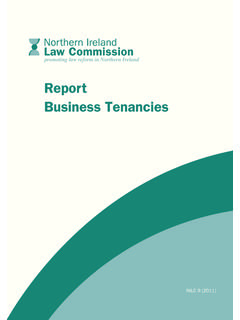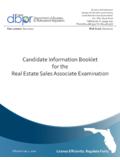Transcription of Landlord & Tenant Act 1954 - Practical Conveyancing
1 This edition, 23 November 2005. Landlord & Tenant Act 1954. Contents Please click on any heading to go straight to that page Landlord & Tenant Act Jacqui Joyce Introduction 04. Contracting out of security of tenure 08. Surrenders 33. To whom does the Act apply? 40. Information gathering section 40 notices 45. The renewal process notices and counternotices 55. The renewal process applications to the court for a new tenancy 63. Termination proceedings by a Landlord 71. Changes to the Civil Procedure Rules 78. Termination of fixed-term tenancies by a Tenant section 27 100. Interim rent 102. Terms of a new tenancy ordered by the court 118.
2 Compensation 120. KEY. Links to Practical pages and other pages within this document Links to external websites Practice Points occur throughout the text and are displayed in separate boxes. Their position in the text may be indicated where Practical necessary by numbering (eg 1, 2, 3). Practical 2 LTA. Landlord & Tenant ACT. Index Jacqui Joyce Introduction 04 of Lovells Contracting out of security of tenure 08 Jacqui Joyce qualified as a solicitor in 1991 and since then has Surrenders 33 been an assistant in Lovells' property litigation department. To whom does the Act apply? 40. Information gathering She has extensive experience of all types of property disputes, section 40 notices 45.
3 Including acting on several reported cases. Jacqui provides The renewal process notices and counternotices 55 specialist advice to clients in relation to legislative The renewal process applications developments and procedural reforms in the commercial to the court for a new tenancy 63 property sector. Termination proceedings by a Landlord 71 Jacqui is a member of the London Property Support Lawyers Changes to the Civil Procedure Group and a member of the Property Litigation Association's Rules 78. Law Reform Committee. Termination of fixed-term tenancies by a Tenant section 27 100. Interim rent 102 She is also an accredited mediator with the ADR Group and Terms of a new tenancy ordered regularly contributes to property journals.
4 By the court 118. Compensation 120. Main Index 02. Practical 3 LTA. Introduction A brief history 4 A brief history The consultation process 5. The Regulatory Reform The Landlord and Tenant Act 1954 ( the Act') came into operation on (Business Tenancies). (England and Wales) Order 2003 5 1 October 1954. Whilst Part I of the Act contains provisions relating to tenants of certain leases of residential property at low rents, and other miscellaneous provisions, it is Part II of the Act, relating to business tenancies, with which this work is concerned. The main object of the Act is to provide business tenants with security of tenure, enabling them to continue to occupy premises for the purposes of their business so long as they comply with their obligations as tenants.
5 When the contractual tenancy comes to an end by effluxion of time or operation of a Landlord 's break clause, its provisions are continued by the Act as a statutory tenancy and the Tenant is given a right to apply to the court for a new tenancy to be granted to it on essentially the same terms. If the terms of that new tenancy cannot be agreed between the parties, then the court will decide what they are. The Act does, however, make provision for the Landlord to obtain a market rent for the continued occupation by the Tenant , and for the court to return possession to the Landlord in certain specified circumstances, eg if it wishes to occupy the premises for its own purposes, to redevelop the premises, or if the Tenant has committed substantial breaches of the terms of the tenancy.
6 This work is not intended to be a detailed treatise on the current workings of the Act or the law which has grown up around it. There are many other learned texts which deal with these issues. The purpose of this work is instead to look at the reforms to the Act which are brought into effect by the Regulatory Reform (Business Tenancies) (England and Wales) Order 2003 and to provide Practical guidance on how these reforms will affect the day-to-day practice of persons dealing with this area. In this work reference has been made to the Guidance Note produced by the Office of the Deputy Prime Minister (ODPM) which is responsible for the reforms.
7 Practical 4 LTA. Introduction The consultation process The Act has been amended once before by the Law of Property Act 1969, following recommendations from the Law Commission. In 1988, the Law Commission published a working paper in which it highlighted 19 aspects of the legislation which might merit reform. A further report was issued in 1992 and a formal consultation paper was issued in March 2001. The latter proposed that the amendments to the Act should be by regulatory reform order (RRO) rather than through a normal Parliamentary Bill. The Regulatory Reform Act 2001 allows ministers to use such RROs to reform primary legislation and, in particular, to remove burdensome regulations.
8 These RROs must not, however, reduce or remove any necessary protection or prevent anyone from exercising an existing right or freedom which they might reasonably expect to continue to exercise. Also any burden imposed under an RRO must be proportionate to the benefits which are expected to result from its creation. It was against these background constraints that the reforms were drafted. The Regulatory Reform (Business Tenancies). (England and Wales) Order 2003. The documents to look at We have attached the main statutory documents as a separate Source Materials PDF which you can download from here: 1 The Act: the 1954 Act as amended.
9 This is the revised version containing all amendments 2 The Forms: these are the official versions of the prescribed forms set out in the 2004 Forms Order 3 The Order: The Regulatory Reform (Business Tenancies). (England and Wales) Order 2003. This is the Order that brought about the sweeping 2004 changes to the 1954 Act 4 Forms Order: The Landlord and Tenant Act 1954 part 2. (notices) Regulations 2004 sets out the detailed requirements of forms and notices under the 1954 Act 5 CPR 56: which should be read with: 6 CPD 56: setting out court requirements in LTA 1954 litigation Practical 5 LTA. Introduction Are the changes retrospective?
10 The short answer is no'. The transitional provisions are set out at Art 29 of the Order. This is at Appendix 3 to this work. Each of these provisions is considered in more detail in the appropriate chapter, but the list is set out here for completeness. The transitional provisions provide that nothing in the Order shall have effect in relation to: a section 25 notice served by the Landlord , or anything done in consequence of it, where the notice was given before the Order came into force (Art 29(1)(a));. a section 26 request served by the Tenant , or anything done in consequence of it, where the request was made before the Order came into force (Art 29(1)(b)).





